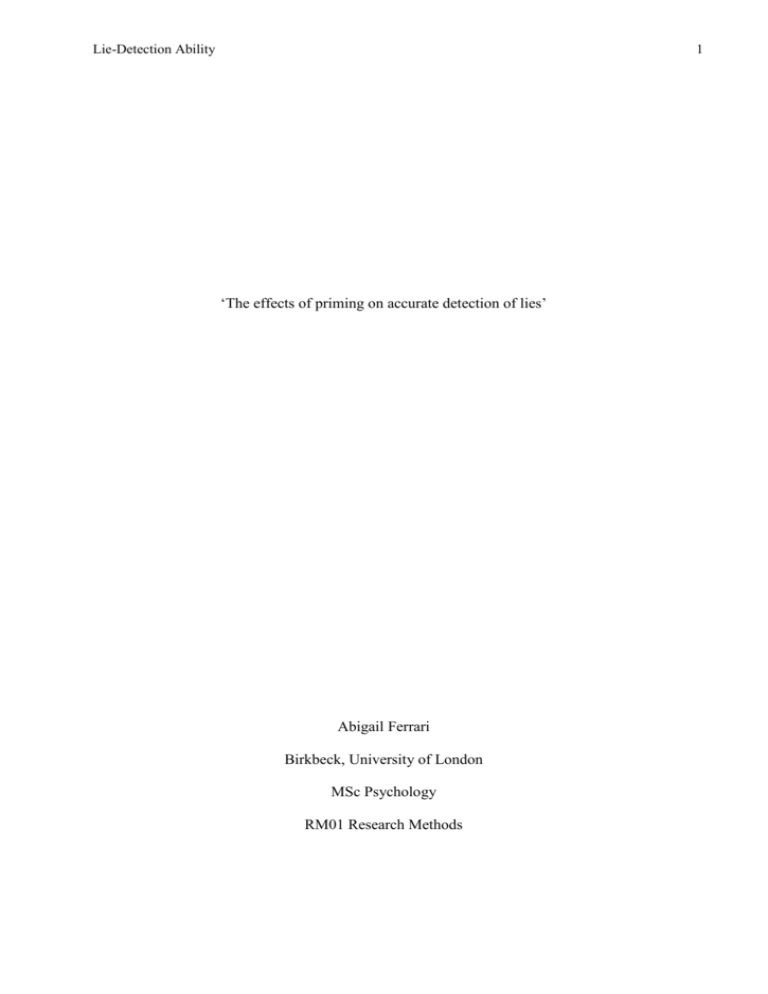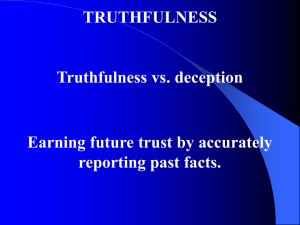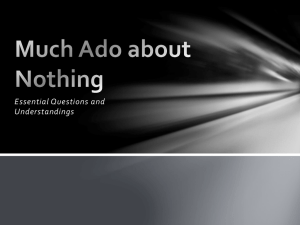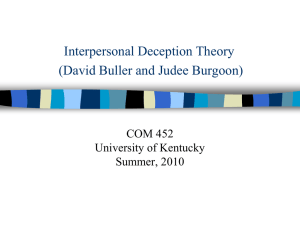Lie Detection Lab Report
advertisement

Lie-Detection Ability 1 ‘The effects of priming on accurate detection of lies’ Abigail Ferrari Birkbeck, University of London MSc Psychology RM01 Research Methods Lie-Detection Ability 2 Abstract Lie detection tests have shown that humans are no better than chance at accurately detecting deception. Current studies show a mean between 50-60% accuracy. This study was designed to investigate whether this is correct for those who are primed before having a deception detection task. Two groups were asked to respond to video clips, one was primed (N=,77) the other was not (N=86). This study is interested in the relationship between priming and accuracy. Those primed were found to have no more ability to detect lies than those who had not been primed. Lie-Detection Ability “Lying has always posed a moral problem” (Bond & DePaulo, 2006) and therefore over the centuries people have invented or introduced a numerous amount of detection techniques in an attempt to uncover deception. Detection can now take many forms and there are many debates as to what the most useful method is; cross-examinations, polygraph tests, fMRIs, brain tests as well as observing non-verbal behaviour have all posed their uses and received their criticisms. Out of all of the detection methods mentioned, the most common is observing human behaviour and seeing if body language, speech and actions will give way to such accusations of lying. For example, American jurors are instructed to judge a defendant or witness’ veracity by considering their “demeanor upon the witness stand” and the manner in which they testify (Judicial Committee on Model Jury Instructions for the Eighth Circuit, Bond & DePaulo, p.214). American courts have even gone so far as to ban lie-detector aids or deception experts in favour of a jury who are the only judges of the witnesses’ believability. With this in mind, how correct are people at actually detecting a truth from a lie? Many people are convinced that they would be able to detect deception but are they mistaking truths for lies or vice versa simply because they are trying to find deception? Freud once stated that “No mortal can keep a secret. If his lips are silent, he chatters with his finger-tips; betrayal oozes out of him at every pore.” (Freud, 1905) However, Ekman and Friesen (1969) argue that liars guard themselves against such ‘oozing’ of signs that could betray them. Furthermore, Ekman (2001) affirmed that most “inferences of deception are mistaken” because there is “no foolproof sign of deceit” (Ekman, 2001 in Bond & DePaulo, p.215). In addition, Bond and DePaulo state that “When telling white lies of the sort often studied by researchers, people have no reason to appear tormented. Thus, they should often be judged truthful.” (Bond & DePaulo, p.216) According to such research then the accuracy of correct judgements should be low as people are either too guarded against giving themselves away, or little lies do not carry the ‘scene’ of moral torment most people connect to lying. 3 Lie-Detection Ability Overall, Bond and DePaulo (2006) have found that people are only slightly better than chance at being able to detect deception. According to Levine et al., (1999) participants in deception detection tasks tend to believe more than disbelieve and so “people judge honest messages correctly more often than lies, and people correctly identify lies at rates lower than 50%” (Levine et al., 1999 p.848) However, it is interesting to see if there is a difference in the accuracy scores if participants are being primed or trained to accurately detect deception. Priming is where exposure to a stimulus influences a response to a later stimulus, which in this case is priming receivers to expect deception. In looking at the accurate ability of human lie-detection when primed, it is useful to look at the television series Lie to Me, of which Levine, Serota and Shulman (2010) have found valuable to their research. The programme demonstrates to the public how lies can be detected by observing nonverbal behaviour. “Lie to Me is based on real-time observation of specific behaviors indicative of lying. The preponderance of research demonstrates that the exact opposite is true.” (Levine, Serota and Shulman, p.848) Participants in Levine et al. study either watched an episode of Lie to Me, a different programme, or nothing. They then judged a series of interviews as being either deceptive or truthful. “Lie to Me viewers were no better at distinguishing truths from lies but were more likely than control participants to misidentify honest interviewees as deceptive.” (Levine et al., p.847) Watching Lie to Me reduced truth bias but did not improve the overall detection scores. In other studies such as Levine, Feeley, McCornack, Harms and Hughes (2005) training participants to look out for certain signs lead to small gains in detection accuracy (an improvement of 3% to 5%). Therefore, from previous studies on deception and looking at priming for deception, is there a big enough increase in accurate detection scores to warrant priming as being the reason? The study of this research report is to see if priming participants to detect deception can lead to the participant accurately identifying lies. According to Buller and Burgoon (1996) “Theoretically, receivers are more likely to perceive a person as truthful if they are interacting with that person rather than seeing the person on videotape.” 4 Lie-Detection Ability This study is also interested in receivers’ accuracy in judging the veracity of statements over video. Participants will clarify short video clips as either lies or truths whilst only half of the sample group is primed for deception. Will the results mimic those of previous studies, or will there be a significant difference due to the element of priming which is absent in other studies. Half of the video clips are truths, and half are lies; hence, even if the participant was guessing, we can expect to achieve 50% correct classifications. Kraut (1980) carried out 10 experiments such as the one just mentioned. He found a mean accuracy rate of 57%, and consequently concluded that “the accuracy of human lie detectors is low.” (Kraut in Bond & DePaulo, p.216) Vrij (2000) replicated Kraut’s studies and found an average of 56.6% accuracy. Having looked at previous studies of deception, this study is looking for a significant increase in the accurate number of detections from primed participants; and these should be relatively higher than those who were not primed in this study. 5 Lie-Detection Ability 6 Method Participants One hundred and sixty three participants (N=163) completed all conditions of this study: 121 were female and 42 were male. Ages ranged from 18 to 52 years, however seven participants did not disclose their age (M = 28.59, SD = 8.339 years, N = 156). Participants were all Psychology students at Birkbeck, University of London who took part as part of their Research Methods module. All participants were naïve to the purpose of the experiment. Design A between-subjects design was used, also known as an independent-measures design. There was one independent variable: participants being primed for deception or not primed. There was one dependent measure that was analysed: the participant’s accuracy of detecting a statement as either a lie or truth. Participants were randomly assigned into two groups according to the independent variable. Materials An information sheet (on blue paper, Appendix A) explaining the experiment was created, as well as consent form (on red paper, Appendix B). The priming manipulation took the form of a questionnaire (Appendix C & D) with a questionnaire cover page (Appendix E), which included demographic information needed for the experiment i.e. age, gender and consent given. There were two separate instructions selected, and therefore two separate questionnaires, for the control group and experimental group: Lie-Detection Ability the primed questionnaire asked participants to answer questions dishonestly and as convincingly as possible but it had to be the opposite of any real opinion. There were 8 statements of which participants had to rate their response to it on a likert scale of 1-4 (1 = totally against – 4 = totally for) and include a short piece of supporting evidence. the no prime questionnaire asked participants to answer questions as convincingly as possible. There were 8 statements of which participants had to rate their response to it on a likert scale of 1-4 (1 = totally against – 4 = totally for) and include a short piece of supporting evidence. There were 40 video clips of 5 participants (2 Males, 3 Females) played through a media player on a computer and projected onto a seminar screen at the front of the room. The clips were head and shoulder shots. Mean clip length was 6.89 seconds (SD= 1.55). However, 38 video clips were used and 2 were removed from the sample due to poor sound quality. There was a response form (Appendix F) for the lie-detection task that contained the statement video number and a tick box for lie or truth next to it. Procedure Ethical approval has been given for this experiment. Participants were tested as a group in a quiet lecture hall. They were asked to sit in front of a questionnaire that had been placed along the rows and to keep at least one-seat length away from another participant. On top of the questionnaire was an information form and consent form. Attached to the back of the questionnaire was the response sheet for the video section of the task. The questionnaires were randomly selected and placed in position so the experimenters did not know where the prime questionnaires were and where the no primes were. Participants were given a reasonable explanation of the experiment at this point, being informed of the questionnaire and 40 short video clips to be watched afterwards. Participants were informed that they would be fully debriefed at the end of the experiment. It was made very clear that 7 Lie-Detection Ability they had the right to withdraw from the experiment at any time, and to withdraw their results after they had participated in the experiment. After reading the information sheet and signing the consent form, participants were then told they had 10 minutes to complete the questionnaire, of which half were primed. Participants were told to read the instructions carefully and to not spend a lot of time writing complicated answers; they were told to keep them persuasive and convincing. There was an example of how the answers should look and then eight statements to answer. A warning of time was given half way through. Once 10 minutes had passed, the experimenter moved on to the video clips; opening the media player and loading the footage. Participants were asked to move onto the response sheet, where a list of 1-40 was set out in a table with tick boxes allocated for truth or lie. They were reminded to continue not to talk during the experiment. The experimenter reminded the group again of the 40 clips they were to watch, and to not judge the clips based on the subject matter of the statements but simply if they thought it was a lie or a truth. The clips were mean length of 6.89 seconds (SD = 1.55). There was 5 seconds between each clip. Between each clip was the numbered title of the next clip i.e. ‘Number 1’ came up before the first clip, and then the first clip played, ‘Number 2’ came up before the second clip, the second clip played, and so on… Participants were aware throughout the task which video number they were on so they could mark next to the correct number on the response sheet. The participant group was then asked to make sure the consent form was fully filled in, and those who had decided they did not want to take part to amend their consent form accordingly. Forms and questionnaires were then collected. Once collected, the participant group was fully debriefed. Informed consent was given. The experimenter introduced the subject of lying and lie-detection and explained that it has been recently found that people who are good liars are also good lie detectors. Experimenter 8 Lie-Detection Ability explained that half of the group were primed for deception. Explained priming in detail, giving the example of Dijksterhuis and Knippenberg’s (1998) study on priming participants with the stereotype of either professors or football hooligans. It was explained that this priming led people become either seemingly more intelligent or a reduction in concentration. A clip was then shown to the participant group of a study where priming participants with the stereotype of elderly made participants walk slower once leaving the experiment than they did when they arrived for it. Participants were fully briefed on priming with these given examples and the aim of the experiment was made clear. To see if there is a significant difference in the responses of those who had been primed to those who hadn’t in accurately being able to detect a lie. 9 Lie-Detection Ability 10 Results A chi-square test of independence was performed to examine the relation between priming and the ability to detect lies. (df = 2, N = 163) = 1.505, p <0.05. Participants who were primed show no difference in ability to detect lies than those who were not primed. The data gathered revealed that there was no significant difference between the scores of the primed group and the control group. Table 1 (above) shows the observed frequencies for the two groups along with the expected frequencies. As can be seen in the medium and high accuracy categories, the no prime group was both observed and expected to have a higher count than the primed group. The prime group was expected to have a slightly higher count in the medium accuracy category but this was not mirrored in the observed count. However, for the prime group, the low accuracy category was expected to have a lower score than the score they actually achieved in the observed count. Lie-Detection Ability 11 Lie-Detection Ability Discussion The present study could not confirm that priming improved the ability to accurately detect deception in the video tape task. As can be seen by the results of this experiment, subjects that were primed to detect lies were no better than a control group in detecting lies. In fact, through the results of the chi square test both the control group and the experimental group achieved below 50%. According to Levine et al., (1999) participants in deception detection tasks tend to believe more than disbelieve and so “people judge honest messages correctly more often than lies, and people correctly identify lies at rates lower than 50%” (Levine et al., 1999 p.848) Bond and DePaulo (2006) found that people are only slightly better than chance at being able to detect deception. This study has found that participants correctly identified lies at a rate lower than 50% which can confirm that they were no better than chance. Thus, the present study can confirm the findings of Bond and DePaulo (2006), who found in their meta-analysis of deception detection in over one hundred studies that subjects were no better than chance in being able to detect lies. And of course, this is when subjects are actually looking for lies and no priming is taking place. According to Bond and DePaulo’s meta-analysis, “psychiatrists, judges, custom officials and policemen score no more highly than the general public on tests of lie-detecting ability.” (Bond & DePaulo in Leslie, I., (2011)) Again, this is when deception is being sought out. This study was primarily focused on finding evidence to associate priming with an increased ability to detect lies. 77 of 163 participants (47%) were therefore primed for this study. This was based on previous research by Levine et al. Levine et al. wanted to look into the effects of priming on liedetection tasks by priming participants to watch a show that would inadvertently help them look out for various signs of deception. The findings of their research concluded that primed participants “were no better at distinguishing truths from lies but were more likely than control participants to misidentify honest interviewees as deceptive.” (Levin et al., p.847) From the findings of this present 12 Lie-Detection Ability study the primed group were no better than the control group at identifying lies, in fact the control group scored higher in the medium accuracy category than the primed group. However, contrary to the results of Levine et al. there is no significant difference between the control group’s accuracy scores and the primed group to infer that truths were misidentified as lies. Primed participants are not seen to be misjudging truths for lies in this study due to the low ratings of the primed group. The accuracy scores are low for all categories overall in this study. On the other hand, Bond and DePaulo state participants do not have a reason to appear tormented when telling lies for research, therefore, they should most often be judged as truthful by others. This concurs with the results of the present study as accuracy scores for lie-detection were low, meaning that participants selected truth far more than deception. This has the opposite effect than what the study wanted to see. However, how skilled a liar was the person in the video clip? Ekman (2001) argues that there is no “foolproof design of deceit” (Ekman, 2001 in Bond & DePaulo, p.215) The subjects who agreed to be videoed knew they were being filmed for a research project. Therefore, they may not have displayed signs of agitation or stereotypical signs of deception. They did not have to face their audience and perhaps were not emotionally connected to the statements they were making. The environment where the experiment took place was problematic in so far as the equipment for the experiment did not work straight away allowing participants to lose concentration and discuss the outcomes of the questionnaires. 3 other assistants had to help in attempting to get the volume on the video clips to load. This allowed participants to analyse the questionnaires and for some to work out they had a different questionnaire than the person sitting next to them. Although participants were asked at all times to remain silent, it was not quite a controlled atmosphere and lost momentum during the experiment. Sex differences and age 13 Lie-Detection Ability Future research conclusion In Bond and DePaulo’s study they look into the statistical consensus of data gathered from deception studies, which was that it “is considered virtually axiomatic … that individuals are at best inaccurate at deception detection.” (Hubbell, Mitchell & Gee, 2001) Data from this study can support Hubbell et al. conclusion due to the very low number of participants that could correctly guess deception. 14 Lie-Detection Ability References Bargh, J.A., Chen, M., & Burrows, L. (1996). Automaticity of Social Behavior: Direct Effects of Trait and Stereotype Activation on Action. Journal of Personality and Social Psychology, 71 (2), 230-244 Bond, C.F., & DePaulo, B.M. (2006). Accuracy of Deception Judgments. Personality and Social Psychology Review, 10 (3), 214-234 Dijksterhuis, A., & Knippenberg, A. (1998). The Relation Between Perception and Behavior, or How to Win a Game of Trivial Pursuit. Journal of Personality and Social Psychology, 74 (4) 865-877 Leslie, I. (2011). Born Liars: Why We Can’t Live Without Deceit. London: UK, Quercus Levine, T.R., Serota, K.B., & Shulman, H.C. (2010). The Impact of Lie to Me on Viewers’ Actual Ability to Detect Deception. Communication Research, 37 (6), 847-856 Vrij, A. (2009). Detecting Lies and Deceit, (2nd ed.) Chichester: UK, John Wiley & Sons. Ltd. 15







